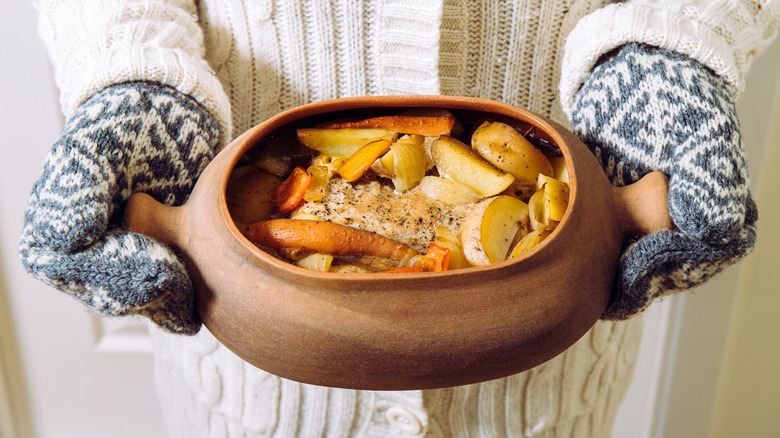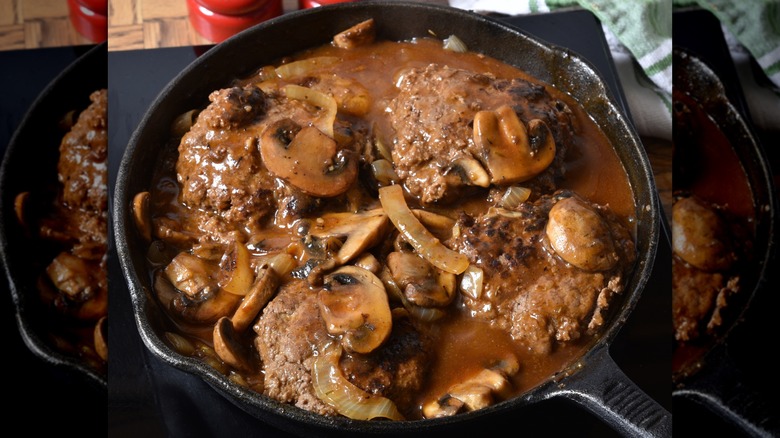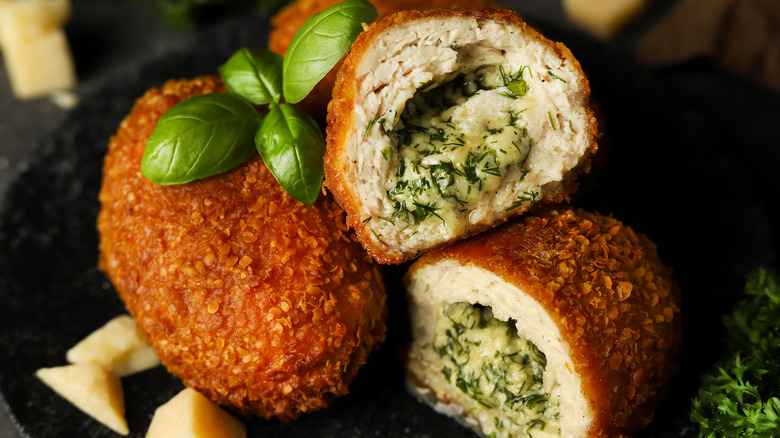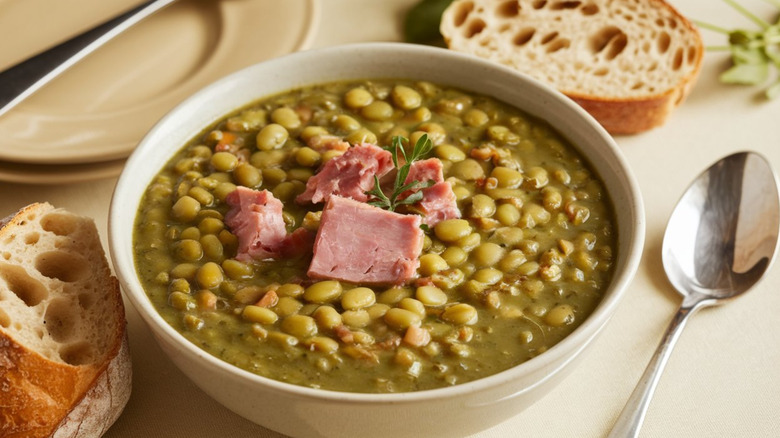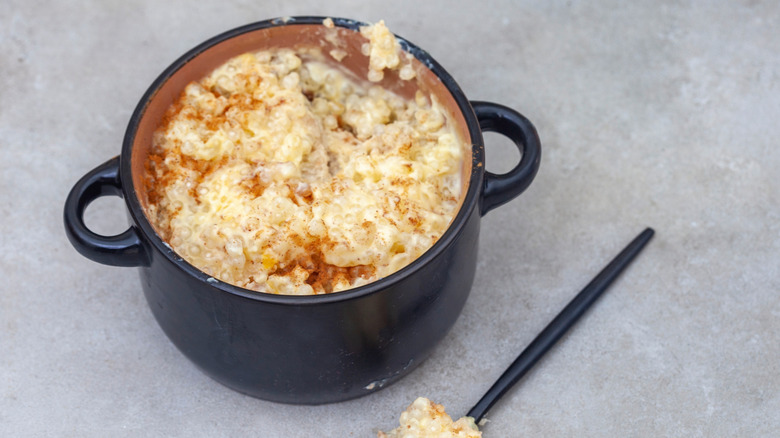7 Old-School Comfort Foods That Should Make A Comeback
Comfort food is great at rising to the moment, on a dark and cold night when you want a warm embrace of ramen or a bright morning, when loudly colorful cereal seems like the most delicious thing in the world. Old-school comfort food, however, satisfies long term, a timeless antidote to all of life's problems. Of course, there are as many nostalgic comfort foods as there are people in the world. These dishes are hearty but not overbearing, and stay delicious long after your plate is cleared.
There's more than a little bit of childlike surprise in these dishes, some delightful flavor or technique that wraps the eater in nostalgia, even if Salisbury steaks or split pea soup weren't part of their regular rotation of years past. Many of them have quite nebulous origins; in a way, everyone who has ever made these dishes has contributed to their creations. These old school comfort foods don't just satiate your appetite; they are an eating experience that deserve a second wind.
Steak Diane
If you think that most modern fine dining establishments are missing an uninhibited spectacle anyone can innocently celebrate, then the steak Diane-spangled restaurants of the mid-20th century are for you. Often served table-side for diners to get a front-row seat to the display, steak Diane's simple gravy of lemon, powdered mustard, Worcestershire sauce, and butter was spiked with cognac and then set ablaze, like a personal crackling fireplace brought to your table. This classic dish has few ingredients — steak, often sirloin or filet, pounded thin and drenched in its boozy sauce — which come alive after being flambéed. It feels both indulgent but welcoming, a meaty hug that needs no accompaniment.
Part of the comfort of steak Diane comes from the mystery of its origins and who it is named after; some attribute its creation to the Drake Hotel in New York City, while others to the Sherry-Netherland Hotel, and the Colony Restaurant, as well. It may be named after the Roman goddess Diana, or after the Drake Hotel chef Beniamino Schiavon's daughter. When the elite hotel and restaurant scene died down in the 1970s, steak Diane became less of a dish you looked forward to and, nowadays, a comforting classic many look back on. Wherever it may have spawned from, steak Diane's ambiguous genesis lends a limitless imagination to the dish only outdone by its outrageous presentation and refined, delicious flavor.
Floating islands
On a similarly visually extravagant bent as steak Diane are floating islands, or Île flottante, a dessert whose presentation screams bougie but the taste of which is pure comfort. Brought onto American plates by Julia Child, this old-school French dessert is greater, and certainly more comforting, than the sum of its parts. A meringue island made lush with caramel sits in a vast sea of custard, an untouched paradise waiting for your spoon to arrive on its shores.
The history of this dish is long, reaching back to the 17th century when they were called snow eggs. There was also a brief detour during the 20th century, during which ladyfingers were added to the dessert. There's also some delicious discourse concerning how to cook the merengues; some recipes instruct you to bake the egg whites, while others poach them in a milky liquid, which is then used to make the custard sea. A straightforward, flavor-packed classic found in old-school French bistros and households alike, floating islands deserve a comeback on your table.
Hamburg steaks
Get a hamburger delivered to your house, chuck the buns off your plate, and you have a vintage classic: Salisbury steak, which is less a steak and more a ground beef patty often smothered in a dark gravy, best enjoyed in front of a sputtering, grainy television. Take away the television and the gravy and travel back in time about 150 years, and you have a Hamburg steak, an Americanized term that refers to a beef patty with chopped onions inside. Whatever time-traveling shenanigans you find yourself in, you'll enjoy the simplicity of cutting into a mound of meat, equally crispy and soft.
During the era of T.V. dinners, Salisbury steaks were often served with mushroom gravy; a side of mashed potatoes and peas wouldn't be unwelcome. Nowadays, you'll sooner find a burger with an extra bun slipped in the middle than one without any buns at all. Interestingly, the Hamburg steak has seen a resurgence in Japanese cuisine, substituting the mushroom gravy for a sticky, ketchup-soy barbecue sauce.
Venture forth with this homemade steak served with a mushroom gravy, and T.V. dinners can come back as if they never left. Any way you cut it, a Salisbury steak is pure comfort that cascades with each bite.
Chicken Kiev
There's something about deep-frying — the hotter-than-hot oil enveloping the contents of the pot in a sizzling blanket, the greasy, crunchy shell that results — that would make a boot taste good. Chicken Kiev is certainly no boot; this upgraded fried chicken takes you so far past comforting it loops back around again to become one of the most purely warming dishes around the world.
This dish takes a bit of surgery: pounded chicken breast encases a mound of butter, often flavored with herbs and garlic, before being breaded and fried to oozy, golden perfection. You'll want to swim in the pool of butter that bursts from the chicken when you slice into it. This is a glorious Pandora's box: Once you free the melted butter from its poultry cage, you'll never be able to eat fried chicken any other way.
It remains unclear how chicken Kiev actually made its way around the world. French, Russian, Ukrainian, and New York chefs are all credited with its creation across competing accounts, with the latter renaming the classic French dish of chicken supreme to its current title in order to attract Russian immigrants searching for a taste of home. There were oodles of recipes in the 1970s for chicken Kiev, but its popularity has somewhat fallen since. If you want to revive chicken Kiev, try this trick to dress up homemade steak with compound butter and use it instead to stuff the inside of the chicken; here, the only limits to what goes in the butter are your imagination.
Split pea soup
Comfort doesn't just mean meat and potatoes: split pea soup is a vegetable-forward, hearty meal that can warm up a crowd from within. This is a classic soup that makes great use of leftovers after holidays like Easter or Christmas, when you might have a few good ham bones lying around; it goes great served with a slice of dark, crusty, buttered bread. As a meal, split pea soup goes back thousands of years, but the version we know today likely stems from the Dutch, whose cuisine influenced colonial America. Similar to lentils, dried split peas can be soaked and then cooked with stock and broken down, resulting in an incomprehensible creamy soup. Though ham adds a smoky depth, it can easily be made vegan with vegetable stock and even liquid smoke.
This was a cheap, filling meal that families made during food shortages; in the latter half of the 20th century, it wasn't a good year without a few massive pots of the (admittedly off-putting) green soup peppered throughout the holidays. Nowadays, split peas might even be hard to find at your grocery store. Nonetheless, the amount of flavor that arises from a delicately curated list of inexpensive ingredients is exponential, and spells comfort in a way that's both vintage and delightfully new.
Tapioca pudding
For those sly party planners scheming to stir up trouble at your next holiday get-together, look no further than tapioca pudding, the old-school dessert that remains controversial today. Tapioca might be most often encountered in boba tea, but those bulbous pearls at the bottom of your cup once had a second, even more decadent home. The American tapioca pudding you may be familiar with debuted in Boston in 1894, and has been used as a blank canvas for experimental flavors ever since. Creamy tapioca pudding was popular in the Betty Crocker cookbooks of yore, and unleashes a familial comfort onto any who bask in its gelatinous glow.
Much like rice pudding, tapioca is cooked in milk, sugar, and eggs until thick and enticingly gloopy. Some recipes include whipped egg whites which you then fold in at the end, which makes a pudding that is fluffier and foamier.
Texturally, tapioca pudding can be hit or miss, if the chef's heart is not in it. The controversy over this old-fashioned dish comes from those who have eaten it in its lackluster state; for the adventurous home cook, tapioca pudding can be an ultimate comfort dessert.
Chicken cordon bleu
Chicken cordon bleu is an edgier, more French cousin to Chicken Kiev, with the herby butter in the Kiev being replaced with Swiss or Gruyère cheese and a slice of ham. However, cordon bleu more so resembles a schnitzel, pounded thin and trapped by breadcrumbs fried to a toothsome crunch. The name means "blue ribbon" in French, which is what very well should be awarded to the dish for its unbeatably warm and homey nature. A Swiss version uses veal instead of chicken for even more extravagance.
Along with steak Diane and chicken Kiev, this was another stop on the trail to amp up a home cook's kitchen in the middle of the 20th century, bringing crispiness and funk to a previously soft-edged environment. Some claim that American demand for the dish exploded after WWII veterans grew fond of European cuisines while stationed abroad. You could buy a pile of these in the freezer aisle several decades ago; now, it is relatively rare to see on a restaurant menu, and even more rare for it to appear on a dinner table at home. This deserves a spot on tables around the world, whether for holidays or just a rainy day. There's a brightness to its humble gratifying effects which gushes from your plate to your stomach.

